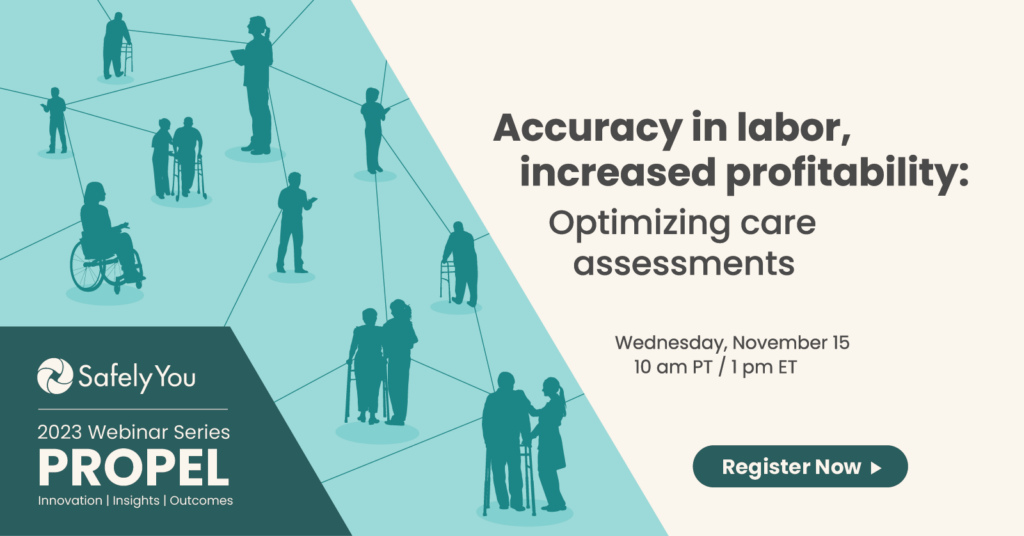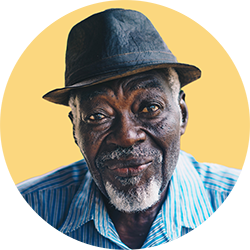Research reveals the impact and costs of falls on individuals and senior living communities — and how we can address this crisis
We surveyed over 400 executives and care providers across senior care, as well as nearly 1,000 American adults 42 and older.
According to the Centers for Disease Control and Prevention (CDC), about 36 million people 65 and older experience a fall each year. In 2020, falls were the leading cause of death from unintentional injury among older adults.
A few additional sobering statistics:
- Every second, an older adult (65+) suffers a fall in the U.S.
- Each year, $50 billion is spent on medical costs related to non-fatal fall injuries; $754 million is spent related to fatal falls.
- Serious and fatal falls are increasing; fall death rates among adults age 65 and older increased about 30% from 2009 to 2018.
For the inaugural State of Falls report, we wanted to deepen our understanding of both how Americans feel about aging and falling, and the true impact falls have on adults residing in—and out—of senior living communities. Because with a greater understanding of a problem we can work towards more effective, transformative solutions.
Here’s what we found:
- For Americans 42 and older, the fear of aging and falling is real. For many, the worry that comes with caring for an aging loved one is acute and constant. For others, the risks that come along with aging—such as cognitive decline, falls, and deteriorating health—lead to anxiety.
- For senior care providers, falls impact staffing, quality of care, and consistency of care.
The risk of falling begins as an individual ages in the home, and follows them as they transition to a senior living community. A family member’s worry follows their journey. Senior care executives who understand and address this have an advantage against those who do not.
The State of Falls goes beyond understanding the impact or number of falls. Our research also includes understanding what it takes to reduce fall risk and help prevent falls across senior care. And, there’s very good news: though many think falls are inevitable, falls can be prevented. We just need the right people, processes, and technology—all working together.
Together we can design a better and safer future for seniors. This is the beginning of our transformative journey towards a world where falls are not a leading cause of death or accepted as “something that happens,” but, rather, something we can dramatically reduce.
Pulling back the curtain: a snapshot of falls
Falls are a regular part of life. When we’re young, falling is practically a daily experience as we run around, carefree and untethered from worry about the consequences. But as we age, our risk factors for falls and ability to “bounce back” change. When an older adult falls, the results—both physically and emotionally—can be significant.
- Nearly half (45%) of American adults over 42 have experienced a fall in the past five years, with more women (48%) than men (42%) having fallen.
- The top emotion following that fall was embarrassment and shame (44%), followed by anxiety (43%) and fear about getting older (28%).
- Following a fall, nearly 6 out of 10 were injured.
- And, for 1 out of 4 (26%) men, the fall led to a move – either in with a caregiver or facility (women: 11%).
While the majority (88%) of American adults prefer to age at home, that is not always an option if a person requires around-the-clock assistance and/or monitoring. For adults who move into senior living, the perpetual challenge for that community is how to cultivate a level of independence in a safe environment.
Despite all efforts, falls remain a complex challenge across senior care. In fact, each second of each day in the United States, an older adult has a fall. So, for each step we take, someone aged 65 or older is falling. And for those living with Alzheimer’s and other forms of dementia, fall rates increase—they fall twice as often as those without cognitive impairments, about four times per year. WIth the increasing aging population, fall numbers continue to grow, presenting a growing challenge for senior care providers.
Here’s what we heard from the over 400 executives and care providers in senior care that we surveyed:
- On average, assisted living communities and skilled nursing communities (SNFs) report an average of 260 patient falls per year across an organization;
- 24% of falls resulted in moving residents to an increased level of care;
- 1 in 7 move-outs were related to falls;
- 59% report that falls impact the ability to provide a high level of resident care.
The American caregiver carries stress and worry
When we talk about falls, it’s easy to focus on the person who is at risk of falling or who has already experienced a fall. The reality is, falls have a much broader impact—especially on the aging person’s family. And that impact is broad; our research reveals that 1 in 4 Americans are currently taking care of an aging loved one.
- 43% have an aging loved one living with them;
- 3 out of 10 have a family member that has been diagnosed with dementia (for 61% it was a parent);
- Nearly 2 out of 10 (20%) anticipate having to take care of an aging loved one in the next 3 years, and 15% in the next 4-6 years.
“The emotional, physical and emotional toll of taking care of a loved one is real and inescapable. In fact, those who experience caregiver strain have a 63% higher risk of mortality compared to non-caregivers of the same age. As their loved ones’ health declines and risks for injuries from falls increase, the heavy weight of worry follows them around. When we identify ways to keep aging individuals safer, we not only improve their experience, but we also remove a bit of that caregiver weight as we give them the confidence their loved one is less at risk of harm today.”
– Glen Xiong, M.D., clinical professor at UC Davis Health and chief medical officer at SafelyYou
For senior care providers, falls impact revenue, staffing, and quality of care
For senior living communities, the research brought to light the fact that falls have an incredible direct and indirect impact on business. Failure to inadequately manage falls can lead to increased costs, reduced staff, and inconsistent quality of care.
- 85% of community executives report that falls significantly impact staff turnover
- Across assisted living communities and skilled nursing facilities, the average annual direct cost of all falls is $380,000.
- For larger senior living organizations—20 or more communities—the average is $712,000; for smaller to mid-size organizations, it’s $158,000.
Additionally, senior care executives reported that two in three prospective residents and/or families ask about how falls are prevented or mitigated in the community, demonstrating the topic of—and fears around— falls are top of mind when an individual is choosing a senior living community.
That’s why these communities are taking steps to help address falls head-on. And while there are obstacles, there are also opportunities. In the next year, 6 out of 10 senior care providers plan to significantly enhance their fall mitigation strategies in the next year, with:
- 56% planning to implement solutions from new tech tools
- 48% planning to reduce fall risk with staff training
- 38% planning to engage with pilot programs and trials to help reduce falls
Fall prevention in our homes and senior living communities
Americans are thinking—and worrying—about falls. A large majority (65.66%) of adults 42+ are proactively taking steps to reduce their risk of falls as they get older.
Those steps include:
- Performing strength exercises (54.15%)
- Doing balance exercises (47.28%)
- Scheduling regular doctor visits to check things like vision and hearing (45.73%)
- Taking supplements, e.g., for bone strength (44.30%)
- Removing clutter/moved furniture to minimize tripping/fall hazards (28.76%)
- Using technology/tools, e.g., an Apple Watch, biometrics tracker, RPM (17.36%)
“People are right to be thinking about falls as they age. Unfortunately, people often make decisions or take steps that put them at a higher risk of falling – or being seriously injured by a fall – without knowing it. For example, many people stop doing certain activities, as they believe those activities will put them at risk. But, when someone decreases their activity level, muscle tone, flexibility and physical agility often decline with it. So, it’s important for adults to not just think about falls, but ensure they understand the right steps to take that will put them at lowest risk of serious injury – or falling in the first place.”
– Sheryl Zimmerman, co-director on aging, disability, and long-term care, Cecil G. Sheps Center for Health Services Research
Twenty-four percent of the respondents reported that they live alone. Of that group, nearly half (45%) say that living alone fills them with more anxiety about aging. And a large majority (87%) said they have friends/family “on call” or “on alert” to be notified if something happens to them, such as a fall or accident.
But the reality is, not everyone can age at home. For many, the move to senior living community is necessary as their risk for injury increases and/or cognitive abilities decline.
For individuals and their loved ones making that difficult decision, the findings reveal a reason for hope: one half of senior care executives believe falls can be prevented, with many actively taking steps to do so.
- 66% have a fall safety team in place to focus on fall prevention and training;
- 8 in 10 train staff in fall safety;
- Nearly all clinical staff (93%) believe that the right technology can significantly help prevent falls.
A future with fewer falls. Transformative change can happen.
Today, falls have a significant and wide impact. From the U.S. healthcare system and senior living industry to the adult caregivers and aging individuals themselves, the toll falls take and costs they carry are immense. And this is just going to get worse as our population ages at an unbalanced rate; the number of Americans 65 and older is projected to nearly double from 52 million in 2018 to 95 million by 2060.
But it doesn’t have to be that way.
We don’t have to accept the status quo; we can help prevent falls from happening and build a safer experience for our aging loved ones and neighbors.
For our senior living community partners, there are four important steps to getting us closer to that future:
- Create a safety & fall prevention team
Only 66% of the senior housing executives and clinical staff we surveyed reported that they have a safety and fall prevention team. While that is a very promising figure, more can be done and senior care providers overwhelmingly agree: 97% report fall mitigation is important to quality of care and 85% agree falls can be prevented. Ideally, every community will have an individual and/or team that focuses on the problem of resident falls, and regularly re-evaluates their fall prevention protocols. If falls increase or decrease, this team should understand why, and revise those protocols accordingly.
- Prioritize and conduct regular fall training
Seventy-three percent of senior housing executives and clinical staff report that adequate training significantly impacts the ability to provide a high level of care. And when they reported a decrease in falls, 32% of them cited trained staff as the reason for improvement. In our work with senior housing communities, we have found that those who conduct training consistently throughout the year (in addition to their other fall prevention measures) have lower fall rates than those who do not.
Dr. Xiong continued, “It’s critical that training does not just include what happens after a resident has experienced a fall, but spends a significant amount of time on the prevention of falls. From resident checks to understanding the factors that put a resident at an increased risk of falling, clinical staff can begin to mitigate the factors that would otherwise lead to a fall.”
- Integrate technology into your fall prevention programming
With 46% of senior housing executives reporting that labor is a top challenge, we as an industry need to identify strategies and tactics that help existing staff deliver high-quality resident care and prevent falls. Technology is one way to do that: 93% of clinical staff believe that the right technology can significantly help prevent falls. In fact, technology tools have a direct positive impact on many areas of business. The most frequently mentioned by senior housing executives and clinical staff alike are: safety (86%), fall mitigation (79%), staff satisfaction (61%) and resident/patient care coordination (56%).
At SafelyYou, we have found that when our artificial intelligence-enabled technology is implemented by senior housing communities, emergency room visits due to falls decline as much as 80%.
- Leverage data to improve fall prevention and safety protocols
The deployment of a new tactic – e.g., implementing a new technology – represents a rich opportunity to monitor and measure the results, and inform future efforts. For example, if the data reveal the majority of falls occur between the same two-hour window each day, protocols can be put in place to increase resident checks and execute new mitigation efforts.
Our technology has recorded thousands of hours of falls, and our team reviews those videos to better understand the situation surrounding each. With that trove of data and insights, we have a better grasp on the falls that occur in senior housing communities across the U.S. For example, our SafelyYou data has revealed that the majority of falls happen between 6-9 pm and 3-6 am each day, making nighttime the most dangerous for residents. Armed with this information, care teams can revise protocols to mitigate the risks, and measure the impact over time.
For caregivers of an aging loved one at home, here are four things you can do to lower their risk of falls:
- Manage sleep disruptions
When the sleep-wake cycle is disrupted, it puts people at greater risk of falls. For loved ones being cared for at home, there’s an important question for caregivers to ask: “What can we do to manage or fix sleep disruptions?” Something as simple as maintaining the right temperature for sleeping could prevent someone from waking up and falling on their way to get that extra blanket.
- Be aware of the time – of day, week, year
“Sundowning” is a term we use for the increased confusion and agitation older adults can experience in the late afternoon or early evening. It can be characterized by shouting, cursing, and increased movement. This is a time for higher risk of falling.
- Understand medication side effects
Some pain medications, particularly narcotic medications, can cause problems with coordination. What’s more, psychotropic medications can also increase the risk of falls, especially antipsychotics. Anyone that is on these kinds of medications, or is caring for someone taking them, should be aware of this heightened fall risk and make changes to their environment accordingly.
- Follow consistent staffing and care patterns
Staffing patterns – e.g., rotating family members or caregivers missing their rounds and disrupting a patient’s usual routine – can be a source of disruption or calmness and stability. This can leave a patient feeling confused, neglected, or uncomfortable, which are emotional triggers that can easily instigate anxious movement, and ultimately, falls.
“Our report confirms what many families with aging loved ones know too well—falls are a crisis, and it will only grow as our aging population grows. The cost of falls is enormous, taking huge physical, emotional, and financial tolls. For those living with Alzheimer’s and other forms of dementia, the impact of falls multiplies. These individuals fall twice as often as those living without cognitive impairment, and they’re sent to the ER much more frequently because they can’t tell you how or why they fell. I started SafelyYou to help end that, to help give a voice to my own loved ones living with Alzheimer’s disease, and to advocate for them when they couldn’t advocate for themselves. As a company dedicated to creating a world where falls are fewer and dementia care is elevated, sharing this report is an important step in serving our mission and continuing to support residents, caregivers, families, and senior living operators working to reduce fall risk.”
– George Netscher, founder and CEO of SafelyYou
SafelyYou is empowering safer dementia care with world-leading AI video technology and 24/7 remote clinical experts. To learn more, visit https://safely-you.com.
A future with fewer falls begins with a single step.
To get started, download the report.
SURVEY METHODOLOGY
SafelyYou commissioned Merrill Research to conduct quantitative and qualitative research of 210 executives and 200 care champions at care facilities across the U.S. The research was conducted in April/May 2022.
SafelyYou conducted an online survey in July 2022 to measure and quantify Americans’ sentiments around falls and aging. The survey captured responses from a broad distribution of 1,249 Adults (42+) in the U.S.





